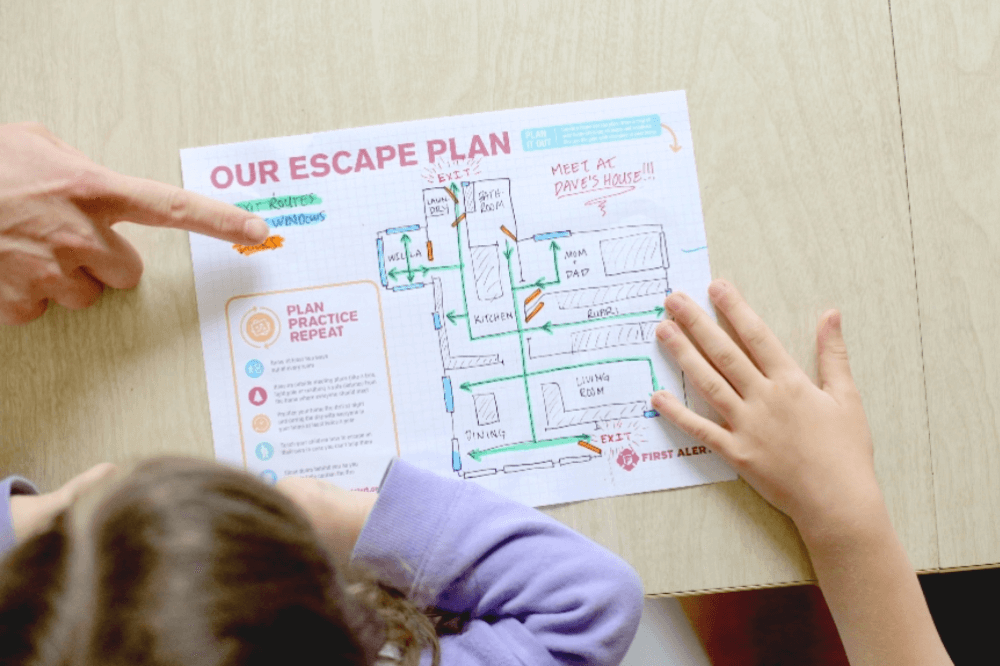How to Plan Your Emergency Escape Route

Did you know 50% of homeowners in the U.S. don’t have an emergency escape plan?* In the event of a home safety emergency, every second counts. According to the National Fire Protection Association (NFPA), you may have less than two minutes to escape after your smoke alarms sound. That's why it's important to be prepared by planning and practicing an escape route with the entire family for safe evacuation. By planning, practicing and repeating your emergency escape plan, you can help ensure a safe escape.
Help protect your family by preparing a plan to help them escape to safety in the event of an emergency. The first step in emergency preparedness is to create a home escape plan by downloading and printing our Escape Plan Worksheet. This makes for a fun activity and helps your kids remember how to escape in an emergency if the smoke alarms sound.
Then sit down with your family and draw a map of your home showing the doors and windows in each room. Remember, every room should have at least two emergency exits. When mapping out your family's emergency plan, be sure to also include an outside meeting spot like a tree, light pole or mailbox that is a safe distance away from the house.
After you and your family have created a map, it's time to plan, practice, repeat to ensure everyone is prepared in the event of an emergency!
Having an emergency escape plan is only part of whole home safety. Smoke and carbon monoxide alarms provide you and your family with an early warning, giving you time to safely escape. Learn more about the importance of emergency preparedness and having the necessary fire and carbon monoxide protection throughout your home.
Make an Emergency Escape Plan
- Walk through your home with your family and identify multiple exits out of each room in the house. If windows or doors are blocked, clear them so they can be easily accessed and opened to exit through. It is recommended that you have 2 exit routes from every room in your house.
- For two story houses, consider equipping bedrooms with escape ladders to provide additional, safe evacuation routes.
- When escaping from a business building, employees should follow the escape plan procedures put in place by that business.
- Dedicate someone to assists pets, small children, infants, elderly, or those with disabilities out of the home.
- Assign a meeting spot outside that is a safe distance away from your house like the mailbox, tree or neighbor’s house. It is important that everyone in the household knows where to meet once they get out of the house.
- Ensure your street address is clearly visible on your home or mailbox for emergency first responders.
- If you have children, teach them how to call 9-1-1 once outside at your meeting spot and help them memorize your home address.
Practice Your Emergency Escape Plan
Once you have your emergency escape plan, it’s time to practice the evacuation route. The NFPA recommends executing your emergency escape plan twice a year, as well as at night. It is a good idea to draw a map of your home and plot multiple exits out of every room, so everyone knows the evacuation plan. Knowing you have a safety plan in place in the event of an emergency will not only give you peace of mind, but confidence that your family is prepared. To get started, download our home escape plan worksheet.
If the Smoke Alarms Sound:
Smoke alarms are just as important as your emergency escape route because they alert your family of a potential danger. Install smoke alarms in every bedroom, outside sleeping areas and on each level. Be sure to test them monthly and replace the batteries every six months, or for hassle-free protection, upgrade to 10-year sealed battery alarms to eliminate the need for battery replacements. Remember, you may have less than minutes to escape so plan, practice and repeat your escape route to help protect what matters most.
- Follow your family’s escape plan.
- Get low and crawl under the smoke.
- Close doors behind you as you leave to slow the fire from spreading.
- Once everyone is out, stay out! You should never return into a burning building. Please leave this to the fire fighters and inform them if someone is missing.
- Call 9-1-1 from outside the home.
Other Preventative Safety Measures
Take these preventative safety measures into consideration to help reduce your risk of fire.
- Make sure all kitchen appliances are in proper working order and are unplugged when not in use.
- While you are cooking, never leave the stovetop or oven unattended. A skillet or pot could easily overrun and catch fire.
- Ensure there is nothing surrounding the stove while it is in use, like dish towels or food scraps, as they are potential fire hazards.
- Never leave lit candles or fireplaces unattended. It is important to be present near an open flame.
- Regularly have all vents and furnaces checked to help ensure your home is operating as safely as possible.
- Keep a fire extinguisher on every level of your home. Read the directions to be sure you know how to use it and regularly check it so in the event of a small fire, you have a working fire extinguisher and know how to use it.
*First Alert Consumer Target Identification and Segmentation Report, Insights in Marketing, June 2016